
















|
China’s Long Stone Serpent; The Great Wall (Part Two)
by Chalerm Raksanti
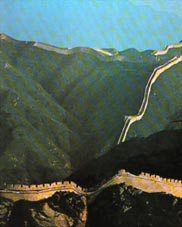
From Chengde to Zunhua and Badaling
Approximately fifty miles due south of Chengde lies Zunhua. Here the burial grounds of the Qing emperors, and their tombs, are sheltered from the evil
influence of the north winds by a range of hills. Luowenyu Pass winds through these same hills and the Great Wall follows their contours. The strategic importance of this pass
was confirmed in 1933 when outnumbered Chinese troops held off a Japanese invasion force for seven days. This pass, like much of the approachable areas of the Wall is visited
by Chinese tourists fortunate to have enough free time for a cultural holiday. Chinese heroes defended this pass, and there is an air of memorial about it, even though these
days, the war-damaged, unrestored section of the Wall runs through fruit orchards and across a canyon creek. The land surrounding this section is farmland and small plots of
vegetable gardens. Flocks of ducks refresh themselves in the stream while housewives and their children wash lettuce and argue loudly about discarded leaves.
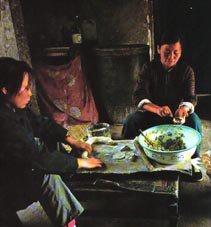 Northern peasants preparing
traditional dumplings for the New Year Northern peasants preparing
traditional dumplings for the New Year
The Zunhua section of the Great Wall dates from the Ming Dynasty. From Shanhaiguan westward past Beijing, the Ming built with bricks and stone. In Shanxi
Province workers also used packed dirt. And in the far west, they used a technique known as terre pise, in which dry soil is placed in rectangular forms and pounded
solid. The forms are then raised and then the process is repeated until the desired height is reached. In the eastern portions of the Great Wall, portions of granite foundation
stones can be found as large as 14 feet by 3 feet by 3 feet. So often, in different sections, the Wall seems to have been positioned purposely in the most inaccessible
locations. Some parts consist of staircases, others are literally vertical. One can almost hear a supervisor say, “Put it there!” And the superhuman work was done. The
boundaries of cultural superiority and protective paranoia are shadowy and subtle.
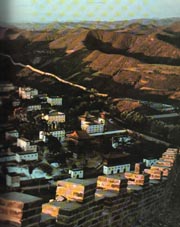 Qing Emperor’s Summer Palace
compound Qing Emperor’s Summer Palace
compound
The human cost of constructing the Wall was awesome. Some official records of various points in time state simply that 300,000 troops built it. But many
later scholars and record keepers put the total at well over a million people, with as many as 400,000 dying along the way. Legends abound which hold that thousands were
entombed within its core. They died where they dropped and their fellow workers built over them, with no thought for the fallen, no prayers for their passing.
In the year 555 when the section near Datong was repaired, two million labourers were conscripted for the job. During the Ming Dynasty, much of the work was
done with convict labour. Chinese literature is filled with tales of the building of this world’s greatest fortress. As with so many things in China, the story is more in the
romance of the telling than in the substance or the facts.
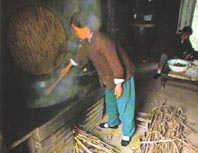 Finished dumplings boiling in a
wok Finished dumplings boiling in a
wok
However painstakingly raised, the Wall has been coming down, bit by bit. At Luowenyu Pass whole sections have been carted away and been used for something
else. During the Cultural Revolution the peasants living nearby used the material for building homes, pigsties and farm buildings. But in the mid-1970’s Chinese authorities
realised the value of this precious historical and cultural monument. They implemented laws against damaging the Wall. All over the nation there are now serious penalties for
defacing or taking away so much as a stone or a brick. Remember, the Great Wall of China was the only man-made structure photographic equipment could see from space.
The Eastern Qing Tombs repose Royal splendour near Zunhua. In times gone by the approach was so sacred that only foot travel was allowed. Today you can ride
up in a Jeep, if you care to. Beneath the richly covered buildings lie the sombre underground burial vaults. Cold and forbidding, they date from the late 1700’s. Emperor Qian
Long’s burial estate is richly decorated with intricate carvings that propound Buddhist themes. One is reminded of the excesses the Chinese people had to contend with during
the days of Emperor rule. For a century and a half, under three great emperors, the Qing Dynasty grew in wealth and territory. The population rose from 120 million to 300
million or more. Unlike so many of the other fallen dynasties, the eventual collapse came not from internal bickering or intrigue, but rather that now China was involved with
an agressive group of international trading nations who were not prepared to let China run all things by her own rules.
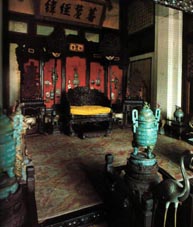 Reception room at the Summer Palace Reception room at the Summer Palace
Badaling, northwest of Beijing, is really the crown of the entire Great Wall. In wave after wave, the Wall rises and falls across the mountains, disappearing
behind one peak, only to reappear at right angles running across another. Here the Wall seems to stretch on forever, its grandeur unmatched and breathtaking. Time stops and one
contemplates the enormity of the thing itself. It is here where the observer stands silent and humble.
The hillsides are covered with maples and other foliage. The steep climb toward a watchtower, which, like much of the Wall at Badaling, has been restored by
the government to resemble as closely as possible the last Ming reconstruction. Along the way patches of Chinese ideograms have been scratched onto paving stones. The climb is
gruelling, but the vantage point at the top is the reward. It is here that one comprehends that the Landsat satellite’s photographs, taken from 600 miles up in space, with
high tech magnification, actually detected the Great Wall of China.
The Thai Hotels Association lets its hair down
One drawback in the hospitality industry is that you never get to celebrate public holidays on the correct days. You are working to make everyone else’s
day fun instead. However, the Thai Hotels Association (THA) Eastern Chapter finally managed to have a party for New Year, even if it was held on the 2nd of February!
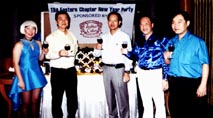 (L to R) Mrs. Rungthip from the
Sunbeam Hotel, mayor Pairat Suthithamrongsawat, Thailand THA president Chanin Donovanik, local THA president Chatchawal Supachayanont and Theerapong Hemwadee from KN Travel
stop to enjoy the fruit of the vine. (L to R) Mrs. Rungthip from the
Sunbeam Hotel, mayor Pairat Suthithamrongsawat, Thailand THA president Chanin Donovanik, local THA president Chatchawal Supachayanont and Theerapong Hemwadee from KN Travel
stop to enjoy the fruit of the vine.
The concept of the late New Year (called the THA Caf้) was warmly accepted by everyone, including some THA members from the other regions in Thailand
who arrived at the Dusit Resort in party mood, such as Chanin Donovanik, the Thailand THA President, Piyaman Kanathavanich President of the THA Western Chapter, and others
like Surat Mekavarakul, President of the Pattaya Business and Tourism Association or Theerapong Hemwadee from KN Travel.
 No one knows how to have more fun
than (L to R) Jintana from The City Sriracha, Suriya from Dusit Resort, Prawet from Dusit Resort, Pornpimol Umraparl from KN Travel, Oranuch from Dusit Resort, Apichaya and
Duangkaew from Mermaid’s Beach Resort. No one knows how to have more fun
than (L to R) Jintana from The City Sriracha, Suriya from Dusit Resort, Prawet from Dusit Resort, Pornpimol Umraparl from KN Travel, Oranuch from Dusit Resort, Apichaya and
Duangkaew from Mermaid’s Beach Resort.
Local THA President Chatchawal Supachayanont threw himself into the role of MC for the party, and even performed a vocal number for the guests. Another of
the members who threw herself into party mode was Rungthip from the Sunbeam hotel, complete with silver page-boy wig.
 Akkarej from Astoria Resort,
Thammarat from Mountain Beach Resort, Boondrik Kusolvitya, City Hotel Sriracha, and Apichaya Chimnanon from Mermaid’s Beach Resort get ready to boogie. Akkarej from Astoria Resort,
Thammarat from Mountain Beach Resort, Boondrik Kusolvitya, City Hotel Sriracha, and Apichaya Chimnanon from Mermaid’s Beach Resort get ready to boogie.
Of course, no party is the same without Mayor Pairat Sutthithamrongsawat, who enjoyed being with such a fun group as the THA and with the other guests
enjoyed the shows from the Hollywood dancers, the Siam Bayshore belles, the Siam Bayview bellettes, the Tiffany girls and acts from the Royal garden Resort and the Dusit
Resort itself.
Pattaya is well on her way to recovery
 Commentary by David Holden, Director of Marketing and Sales, Royal Cliff Beach
Resort Commentary by David Holden, Director of Marketing and Sales, Royal Cliff Beach
Resort
Pattaya is what would be classified in the tourism business as a ‘mature product’. We all know the story of how the tranquil little fishing village
became Thailand’s first international beach resort and went through the classic development process experienced by other resorts around the world during the 1960’s and
1970’s.
Rapid, unplanned development, allied with Thailand’s free and easy controls saw the resort in a position by the late 1980’s and early 1990’s where it
had been overtaken by far fresher and more desirable destinations both in Thailand and internationally.
For large numbers of potential holidaymakers, a seriously polluted sea had fundamentally undermined Pattaya’s attraction as a destination and to keep the
tourism dollars rolling in the city saw a proliferation of the sort of businesses designed to entertain visitors who didn’t really care too much if they would be able to
swim in the sea or not.
While a core market still existed it was not growing and compared to competing destinations was in serious decline. The arrival of the Russians in Pattaya
in the early 1990s was a major boost for Pattaya but was simply helping to compensate for what we were missing out on in other markets.
Shortly after my arrival as director of marketing and sales at the Royal Cliff Beach Resort in January 1994, I set off on a European contracting trip. It
was a sobering experience.
Tour operators I met with would reminisce about the “good old days” when they used to send so many of their holiday makers to Pattaya and the high
satisfaction levels they used to receive from their guests - and compare that with the lamentable results they currently achieved. They would tell me how everyone wanted to
go to Phuket or Koh Samui now and in the worst cases they would threaten to drop us out of their brochures.
In the most extreme cases tour operators would refuse to even feature Pattaya at all in their brochures and, most demoralizing of all, some would even
refuse to meet with me because they felt that it would be a waste of time talking to a hotelier from Pattaya.
It was obvious that we were fighting for our lives as a credible international tourism destination. In fact, if Pattaya had been a human being it would
have been in intensive care and the doctors would have been standing around discussing in hushed tones whether now was the time to telephone the patient’s relatives.
It was obvious that something had to change dramatically if the patient was to have a chance - and it was obvious what that change had to be. The sea must
be cleaned. I can tell you from long and painful personal experience, it isn’t easy to persuade a potential family of holidaymakers to fly 5000 miles to a beach destination
where it was not only inadvisable but also irresponsible to swim in the sea.
Assuming the sea could be cleaned there was still another major problem - Pattaya’s image as a “red-light” resort.
Whilst it is true that Pattaya still offers more than the average number of opportunities for adult entertainment there is no doubt that the enforcement of
proper controls over the last few years has helped to improve the situation in Pattaya and to reduce instances of media criticism.
Previously Pattaya was a soft target and it was not easy for Pattaya to defend itself - after all, it was easy to ask why anyone would really be going to a
beach resort like Pattaya when you couldn’t even swim in the sea.
The situation became a self fulfilling prophecy - the bad sea highlighted the adult entertainment, which made it difficult for mainstream tourists to
justify to their friends their choice of Pattaya as a holiday destination, which further reduced the number of mainstream tourists, heightening Pattaya’s dependency on
‘non-mainstream’ tourism and leading to the proliferation of even more adult entertainment establishments, leading to a further worsening perception of the destination
and so on and so on.
If any proof were needed of that, think of other places which have the same sort of nightlife and ask whether they have had the same negative image as
Pattaya. They have been far more fortunate.
Now, after years of work, Pattaya’s waste water system is operational
So what will the cleaning of Pattaya’s sea achieve?
Quite simply, it will be the best money ever spent on Pattaya and will significantly transform the city for the better. Pattaya will be able to visibly
improve as a tourism and meetings destination, as a place to do business, and as a place to live. Just as importantly, the cleaning of the sea has the potential to improve
the lives of the ordinary citizens of this city immeasurably.
With the cleaning of the sea, Pattaya will be able to rehabilitate itself not only as a tourism destination but also as a community.
With a clean sea it will be much easier to attract larger numbers of mainstream holiday makers - families, couples, honeymooners, the sort of holidaymaker
that you see in other beach resorts all over the world.
What will this influx of tourists do?
It will lead to a growth in the tourism infrastructure commensurate with their needs. More restaurants, shopping, family attractions and family
entertainment as well as more mainstream nighttime entertainment.
This will increase jobs - proper jobs with proper salaries which will help to maintain the sort of stable families which can only be achieved through
regular and reasonable income.
The businesses will pay taxes, which can be reinvested in the city infrastructure for the benefit of the residents.
The adult entertainment of Pattaya will still be there - there is no need for a single business to close or to lose a single customer, but, relative to the
growth of mainstream tourism businesses they will slowly become a less prominent part of the overall business mix in the city.
Pattaya is a large tourism city with already probably the best developed tourism infrastructure in South East Asia and with more hotel rooms than
Singapore, so Pattaya need lose none of its current businesses or visitors - there will be room for all.
Once the sea is clean the city planners need only use their imagination.
What about floating pontoons off the main beach for swimmers to swim to, a lake Geneva style water spurt, or how about banning motor traffic from the main
Beach Road drag during daylight hours to create a quiet, safer environment for people to enjoy the beach?
There will be plenty of people who will say that it can’t be done, but who would have thought 10 years ago that we would be close to achieving our goal
of a clean sea?
One thing which will definitely be achieved is an improvement in the image of Pattaya - after all, once the sea is clean the media may discover that there
are other beach resorts that have go-go bars too - all over the world in fact.
The future for Pattaya is truly looking good and the city fathers and government officials who had the foresight and courage to push through the investment
in the water treatment system will one day be seen as visionaries.
Just think about it - Pattaya already has a tremendous tourism infrastructure with something for everyone, beautiful offshore islands, wonderful excursion
opportunities and more hotel rooms than any other beach destination in Thailand. The city offers the best value for money of any developed beach resort in the country and has
an exciting and varied nightlife.
The infrastructure is already there for tourism and with more and more companies deciding to open major facilities on the East Coast we are going to see a
growth in Pattaya as a center for business - and the city is already prepared with a world class, state of the art convention center - PEACH.
The coming years are going to see more and more high spending business and convention guests coming to Pattaya and they will find the resort prepared to
offer them whatever they want.
If any further proof were needed of the returning confidence in Pattaya just look to the scheduled opening of a Hard Rock Hotel and Hard Rock Cafe in
Pattaya later this year - a brand which, I am sure, would not have been interested in being associated with Pattaya 10 years ago.
And what else - well, if all the foregoing was not enough the easy access to Pattaya from the city of Bangkok and from the Bangkok International Airport
will become even easier when the new Bangkok Airport opens on the Pattaya side of Bangkok in a few years time. Pattaya will be an hour’s drive from Thailand’s
international and domestic flight gateway.
A pipe dream? Well that’s what many people thought a few years ago about the chances of Pattaya ever having a clean sea.
The doctors are pleased to report that the patient is out of intensive care and is walking around the ward. The patient will soon be ready to be discharged
and return to work.
The Eastern Seaboard English Speaking Business Club meet again
The second meeting of the Eastern Seaboard English Speaking Business Club was held at the Benjarong Restaurant in the Royal Wing of the Royal Cliff Beach
Resort last weekend.
 (L-R): Members of the Eastern
Seaboard English Speaking Business Club Felix Grieder, Gerrit De Nys, John Kershaw, Michael Murphy (back), John Allen, Andrew Wood, David Wyatt, Graham Macdonald, Anthony
Close and Kim Fletcher met at the Benjarong Restaurant in the Royal Wing of the Royal Cliff Beach Resort. (L-R): Members of the Eastern
Seaboard English Speaking Business Club Felix Grieder, Gerrit De Nys, John Kershaw, Michael Murphy (back), John Allen, Andrew Wood, David Wyatt, Graham Macdonald, Anthony
Close and Kim Fletcher met at the Benjarong Restaurant in the Royal Wing of the Royal Cliff Beach Resort.
The first event attracted many English speakers; however, for this second meeting, it was highly suspected that perfect weather called many to the golf
course or sailing the open sea, as the numbers were down, but it was nonetheless a great success, even as Shenanigans landlord, Kim Fletcher was heard cracking a few one
liners.
Felix Greider, resident manager of the Royal Wing and Andrew Wood, GM of the Royal Cliff Beach Resort, welcomed guests at this second bi-monthly meeting,
which will become more regular, with a proposed yearly schedule to be announced at a later date.
Seaboard Sundowners at Garden Beach Resort
The Seaboard Sundowners meeting of the Australian Thai Chamber of Commerce (ATCC) was held in the most romantic location of the newly refurbished Garden
Beach Resort last Friday. It was a perfect location for the Aussies; drinks were served on the poolside terrace just as the sun was setting behind the palm trees on the
beach. Many people drove down from Bangkok especially for the weekend, as did the newly appointed Australian Ambassador, His Excellency Miles Kupa.
 (L to R) Prof. Ivan Petroff, HE
Miles Kupa, a representative from the Australian Embassy and Steve Martin enjoy networking under the stars at the newly refurbished Garden Beach Resort in Pattaya. (L to R) Prof. Ivan Petroff, HE
Miles Kupa, a representative from the Australian Embassy and Steve Martin enjoy networking under the stars at the newly refurbished Garden Beach Resort in Pattaya.
ATCC chairman Max Lindsay, in his opening address, explained that although the main chamber was in Bangkok, the Seaboard Sundowners meeting and activities
here in Pattaya were an opportunity to show the chamber’s support in the Eastern Seaboard. He then had the honour of introducing the Australian Ambassador H.E. Miles Kupa
and jokingly said to beware, as the Ambassador speaks fluent Thai.
H.E. Miles Kupa then smilingly responded by giving his introductory remarks in Thai and was rewarded with enthusiastic applause. “It is heartening to
discover that The Australian Thai chamber is active not only in Bangkok but also in the Eastern Seaboard,” he said. “It demonstrates the entrepreneurial spirit of success
of the Aussies and the hospitality of the Thais.” H.E. Miles Kupa is a strikingly handsome man whose appearance shows his Danish-Slovene heritage. He was educated in
Australia and has an Asian wife, and had been previously posted to Bangkok before and just loves it.
Under the stars, the Australians networked freely, with the local representative Mark Laurence from the Laem Chabang School of Engineering being his usual
affable self. Other personnel from the Australian Embassy, such as Tony Asome, were also enjoying the balmy night in Pattaya.
On Saturday morning, members visited the ATCC sponsored school, Ban Khao Huai Mahad in Ban Chang. Members enjoyed chatting with the teachers and students
and donating books, pencils and milk. Following the school visit, a friendly game of golf was played at the Eastern Star Golf Club.
Sadly, the much loved executive director of the Australian Thai Chamber of Commerce, Kathy Lindsay is leaving Thailand shortly. Therefore her position will
become vacant and she is looking for a suitable Australian replacement with public relations experience who would be available to replace her.
The Australian-Thai Chamber of Commerce is responsible to its members for the promotion of Australian-Thai bilateral trade and investment. The executive
director reports to the chamber committee, and is responsible for the day to day management of the chamber and assists in guiding the strategic direction of Australian
business in the Kingdom. This is a very important position and the successful applicant will need to display a commitment to the development of the chamber. Those interested
are invited to contact Kathy Lindsay for further details, e-mail: [email protected] or write to the Australian-Thai Chamber of Commerce 20th Floor Thai CC Tower, 889
South Sathorn Road Bangkok 10120 Thailand, tel. 02 210 0216-8, fax: 02 675 6696, web site: www.atcc.or.th
Garden Beach Resort unveils their revamped restaurants
 President of Orchid Asset
Advisors, Robert Dziubla welcomes guests to the reopening of the Garden Beach Resort and its 2 new beautiful restaurants. President of Orchid Asset
Advisors, Robert Dziubla welcomes guests to the reopening of the Garden Beach Resort and its 2 new beautiful restaurants.
The president of Orchid Asset Advisors, Robert Dziubla was present to officially welcome guests to their property, Garden Beach Resort in
Naklua. The resort, which has had a total face-lift following Orchid’s taking control, has two restaurants, which have also been re-vamped and were re-commissioned last
weekend. The poolside bistro style restaurant has been called the Terrazzo Restaurant, while the fine dining restaurant upstairs, looking out over Naklua Bay, is the Bayleaf.
This restaurant was featured in the Pattaya Mail’s Dining Out column recently and was given an excellent review.
Jim Bement playing at MoJo
This Saturday (13th) is your opportunity to listen to piano virtuoso, Jim Bement who is playing at the MoJo Nightclub in Jomtien. If the name Jim Bement
does not play a chord for you, then perhaps names like Kansas, Styx, Yes, ELP, Raw Silk, Area 51, and Cold Sweat bands just might. Still a little baffled?
 Jim Bement has played with the University of South Florida Jazz Laboratory Workshop
including performances with the Brecker brothers. But perhaps it is his classical side you have heard - Jim has given classical concerts including Jehan Alain’s virtuoso
piece “Litanies” and always including Bach trio sonata music. This man is certainly an “all round” musician, with his current directions including more classic music
concerts, a high-energy doo-wop dance band featuring Hammond organ, and more Celtic and other ethnic accordion music. Whew! Jim Bement has played with the University of South Florida Jazz Laboratory Workshop
including performances with the Brecker brothers. But perhaps it is his classical side you have heard - Jim has given classical concerts including Jehan Alain’s virtuoso
piece “Litanies” and always including Bach trio sonata music. This man is certainly an “all round” musician, with his current directions including more classic music
concerts, a high-energy doo-wop dance band featuring Hammond organ, and more Celtic and other ethnic accordion music. Whew!
Jim Bement is in town this Saturday night for a solo concert and will demonstrate the depth of his talent and the width of his style.
Monika Rottmann (the Mo in MoJo) says that it is best to book seats for this concert, either directly at the nightclub behind the Jomtien Complex Condotel
or by phone 01-268 6836.
Round About
by Mekhala

Angkor House
Round About is a round up of where to find goods and services locally at affordable prices. Dealing with any merchandise or services, art and craft,
accommodation, fashion, health, gardening, jewellery, music, spas, cars, mechanics, photographs, travel, teachers, wine or whatever. The Pattaya Mail will track it down for
you. Are you desperately hunting for that elusive object or service? Send in an email to [email protected] and find your answer in this column. Do you have a
brilliant service or products that you want to share with the readers? Email [email protected] or fax roundabout on 038-231675
Are you the person who loves ancient monuments? Does Angkor, Ayuthaya, Borobodur, Sukhothai stone seem mystical, an amazing tribute to a lost culture?
Would you spend days photographing and climbing vine covered ruins? Would you love sandstone, nagas or elephants gracing your garden, or Thai, Indian or Hindu heads in your
home? Then Angkor House is a must to visit.
At North Pattaya Road this magical shop sells sandstone carvings and replicas at affordable factory prices. It is indeed a find, and has now been here in
Pattaya for two years. No more traipsing from one outlet to another comparing prices. There is something for everyone with a huge price range of 550 to 30,000 baht.
These beautiful pieces come directly from the factory in Korat. Angkor House displays mainly sandstone framed pictures and large wall displays but also
bronze, terracotta, pottery, tiles, statues, bowls, pots, lamps even lingams, animals, mythical figures, nagas, elephants, singha, ganesh, Buddha heads, pediments of the
Ramanyana and Khmer friezes in addition to modern Thai style stone. In fact most things Asian that are steeped in history.
Who wants a replica you may say? Well most governments these days and all conservationists oppose pillaging ancient monuments and sacred sites.
The Sandstone pieces are made in the Korat Pottery. Angkor House is a direct outlet, at the moment the only one in Thailand that sells these magnificent
pieces at factory prices.
Korat Pottery makes its artefacts by first photographing the pieces on site, then making clay copies, from which are made the moulds. Then the sandstone is
poured into the moulds. Special sand is used that comes from only one region of Korat. After that, further carving is done on the completed piece. Pottery bowls and lamps and
wall tiles of course are made with traditional kiln methods.
How will you get them home? The delightful Madame Patchyara Nongyai will pack and send by low cost, international secured shipping to your home country.
Telephone Angkor House, 038-426328 Fax 038- 410635.
Pat Travel
Now, if after wandering through the monuments of Angkor House gives you a longing to travel to discover these ancient sites for yourself, Pat Travel in the
same office will fly you there. Why the name Pat Travel? Belatedly I realized it is a contraction of the name Patchara (which means bright diamond in Thai). Pat, it seems, is
a family tradition, Patchara’s two children are both named Pat, her son Pattrawut and daughter Patthamon!
Patchara started the travel agency in Korat ten years ago at the same time she joined forces with her friend in the Korat Pottery Company. Pat Travel
specialises in tours to ancient sites, but deals in all travel both local and international. Currently they are offering a three day two night, return flight to Cambodia,
including visa, airfare and accommodation, for 11,000 baht. For those wanting to travel on and explore the Angkor Wat ruins, the cost is an extra 25,000 to 30,000 baht,
depending on the chosen hotel.
Air tours to Chiang Mai, three day two night including accommodation, are 6,400 baht. For those fascinated by ancient Celtic ruins further a field and
whose thoughts stir to mystery and magic at the names of Stonehenge, the Blarney Stone and the Orkney Islands, then the United Kingdom is the place. Return airfare to London
flying Thai International is 36,000 baht.
Telephone Pat Travel, 038-410647, fax 038-410635.
Antiques, Are They Genuine?
by Apichart Panyadee
Decoys
The decoy, a more or less realistic representation of a bird designed to lure wild fowl within gunshot, is collected primarily within the USA, though
European examples will be encountered and Canadian decoys form an important classification. While many birds have been imitated as decoys, including crows, owls, and doves,
the majority falls into two categories: ducks and shorebirds. In each of these, enthusiasts distinguish between working decoys, which were actually used, or “hunted
over”, and those purely decorative wild fowl carvings. Many well known carvers produced both types. Collectors include duck hunters, folk art enthusiasts, and carving
buffs.
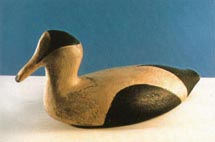 Elder decoy, most likely of
recent construction Elder decoy, most likely of
recent construction
The value of a decoy is primarily dependant upon the reputation of the carver, the rarity of the individual work, and to a lesser extent, aesthetic
considerations. The last are of most concern to those who pursue decoys as a form of folk art. Since a connection with a particular maker is so important the faking of either
maker’s marks or their styles is the customary area of fraud.
Prevalence of fakes and reproductions
Generally speaking, faking of famous makers’ work is uncommon. This is probably due to the fact that collectors of these pieces are very knowledgeable
sportsmen and are familiar with the styles of a particular carver’s work, so the are difficult to fool. Shore birds may bring up to $75,000 at an auction, for example. With
this kind of money at stake the market is small and the collectors are well informed. On the other hand, there are many fakes and reproductions selling for under $1,000 which
are bought by people knowing little about the field, and only seeking a certain “look”.
Points to watch for
Naturally, if the body and paint is new, this is a reproduction. A new decoy will have paint which is distressed to create an illusion of age. New heads
may be joined to old bodies, lost beaks may be replaced, or an older body may be recarved to add feathering to enhance the appearance. Most of this work is crude and easy to
spot. Always be aware of prices, and be cautious of a bird that is selling for well under the market price.
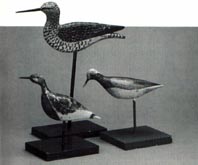 Early 20th century shorebirds Early 20th century shorebirds
Working decoys were painted each year and should show several coats of paint with worn spots, chips and cracks from wear and age. Shot holes can
occasionally show up, but they are not common. Sportsmen do not shoot birds in the water. Wear can be faked with sandpaper and steel wool. Use a magnifying glass. If deep
rough ridges appear, the wear is artificial. True, old wear produces smooth spider web crazing and softened edges.
Few makers marked their birds, though some did. Familiarise yourself with carvers’ signatures. The signature should show appropriate wear. Decoys can be
bought in many places, but reputable dealers with long experience in this field are your best bet.
Copyright 2001 Pattaya Mail Publishing Co.Ltd.
370/7-8 Pattaya Second Road, Pattaya City, Chonburi 20260, Thailand
Tel.66-38 411 240-1, 413 240-1, Fax:66-38 427 596; e-mail: [email protected]
|

Skal
International
|

 Northern peasants preparing
traditional dumplings for the New Year
Northern peasants preparing
traditional dumplings for the New Year Qing Emperor’s Summer Palace
compound
Qing Emperor’s Summer Palace
compound Finished dumplings boiling in a
wok
Finished dumplings boiling in a
wok Reception room at the Summer Palace
Reception room at the Summer Palace (L to R) Mrs. Rungthip from the
Sunbeam Hotel, mayor Pairat Suthithamrongsawat, Thailand THA president Chanin Donovanik, local THA president Chatchawal Supachayanont and Theerapong Hemwadee from KN Travel
stop to enjoy the fruit of the vine.
(L to R) Mrs. Rungthip from the
Sunbeam Hotel, mayor Pairat Suthithamrongsawat, Thailand THA president Chanin Donovanik, local THA president Chatchawal Supachayanont and Theerapong Hemwadee from KN Travel
stop to enjoy the fruit of the vine. No one knows how to have more fun
than (L to R) Jintana from The City Sriracha, Suriya from Dusit Resort, Prawet from Dusit Resort, Pornpimol Umraparl from KN Travel, Oranuch from Dusit Resort, Apichaya and
Duangkaew from Mermaid’s Beach Resort.
No one knows how to have more fun
than (L to R) Jintana from The City Sriracha, Suriya from Dusit Resort, Prawet from Dusit Resort, Pornpimol Umraparl from KN Travel, Oranuch from Dusit Resort, Apichaya and
Duangkaew from Mermaid’s Beach Resort. Akkarej from Astoria Resort,
Thammarat from Mountain Beach Resort, Boondrik Kusolvitya, City Hotel Sriracha, and Apichaya Chimnanon from Mermaid’s Beach Resort get ready to boogie.
Akkarej from Astoria Resort,
Thammarat from Mountain Beach Resort, Boondrik Kusolvitya, City Hotel Sriracha, and Apichaya Chimnanon from Mermaid’s Beach Resort get ready to boogie. Commentary by David Holden, Director of Marketing and Sales, Royal Cliff Beach
Resort
Commentary by David Holden, Director of Marketing and Sales, Royal Cliff Beach
Resort (L-R): Members of the Eastern
Seaboard English Speaking Business Club Felix Grieder, Gerrit De Nys, John Kershaw, Michael Murphy (back), John Allen, Andrew Wood, David Wyatt, Graham Macdonald, Anthony
Close and Kim Fletcher met at the Benjarong Restaurant in the Royal Wing of the Royal Cliff Beach Resort.
(L-R): Members of the Eastern
Seaboard English Speaking Business Club Felix Grieder, Gerrit De Nys, John Kershaw, Michael Murphy (back), John Allen, Andrew Wood, David Wyatt, Graham Macdonald, Anthony
Close and Kim Fletcher met at the Benjarong Restaurant in the Royal Wing of the Royal Cliff Beach Resort. (L to R) Prof. Ivan Petroff, HE
Miles Kupa, a representative from the Australian Embassy and Steve Martin enjoy networking under the stars at the newly refurbished Garden Beach Resort in Pattaya.
(L to R) Prof. Ivan Petroff, HE
Miles Kupa, a representative from the Australian Embassy and Steve Martin enjoy networking under the stars at the newly refurbished Garden Beach Resort in Pattaya. President of Orchid Asset
Advisors, Robert Dziubla welcomes guests to the reopening of the Garden Beach Resort and its 2 new beautiful restaurants.
President of Orchid Asset
Advisors, Robert Dziubla welcomes guests to the reopening of the Garden Beach Resort and its 2 new beautiful restaurants. Jim Bement has played with the University of South Florida Jazz Laboratory Workshop
including performances with the Brecker brothers. But perhaps it is his classical side you have heard - Jim has given classical concerts including Jehan Alain’s virtuoso
piece “Litanies” and always including Bach trio sonata music. This man is certainly an “all round” musician, with his current directions including more classic music
concerts, a high-energy doo-wop dance band featuring Hammond organ, and more Celtic and other ethnic accordion music. Whew!
Jim Bement has played with the University of South Florida Jazz Laboratory Workshop
including performances with the Brecker brothers. But perhaps it is his classical side you have heard - Jim has given classical concerts including Jehan Alain’s virtuoso
piece “Litanies” and always including Bach trio sonata music. This man is certainly an “all round” musician, with his current directions including more classic music
concerts, a high-energy doo-wop dance band featuring Hammond organ, and more Celtic and other ethnic accordion music. Whew!
 Elder decoy, most likely of
recent construction
Elder decoy, most likely of
recent construction Early 20th century shorebirds
Early 20th century shorebirds